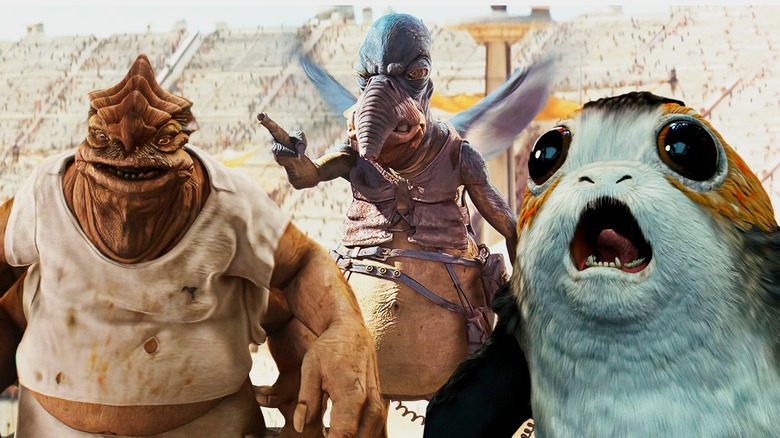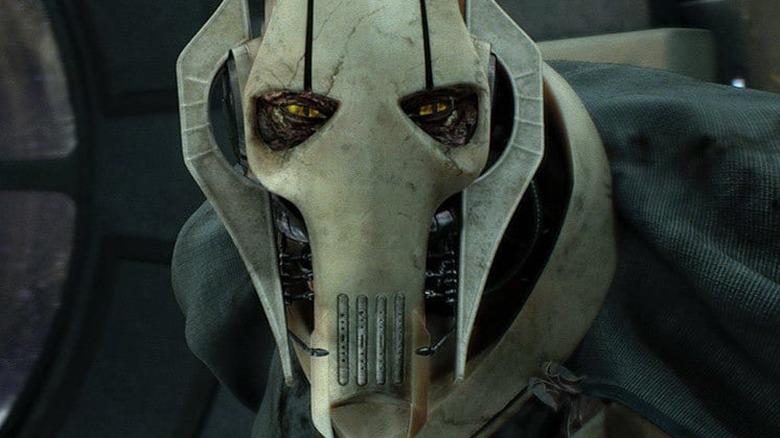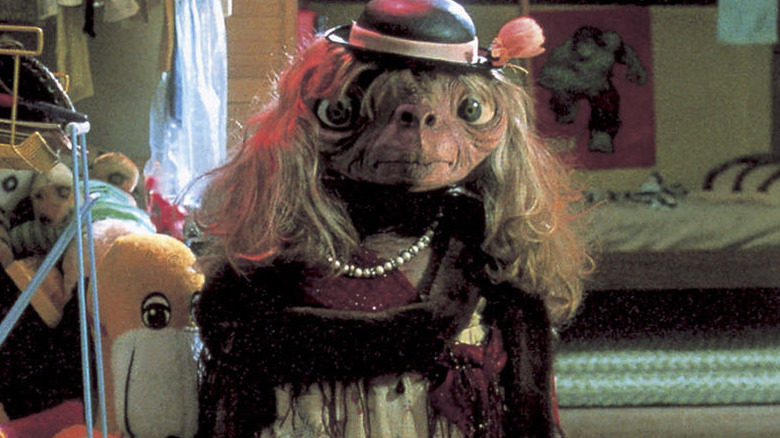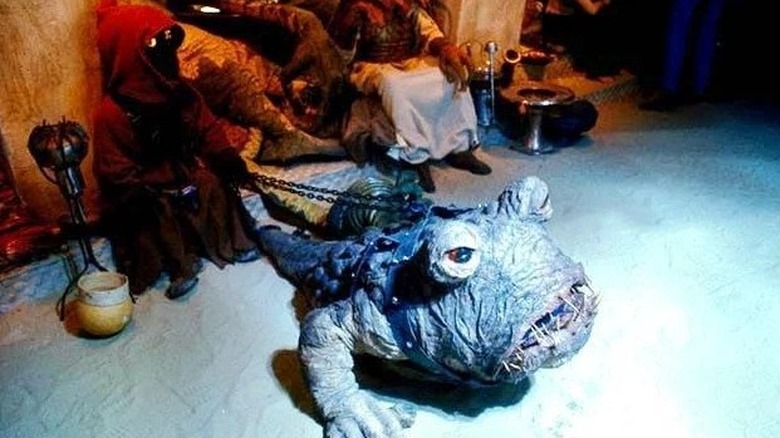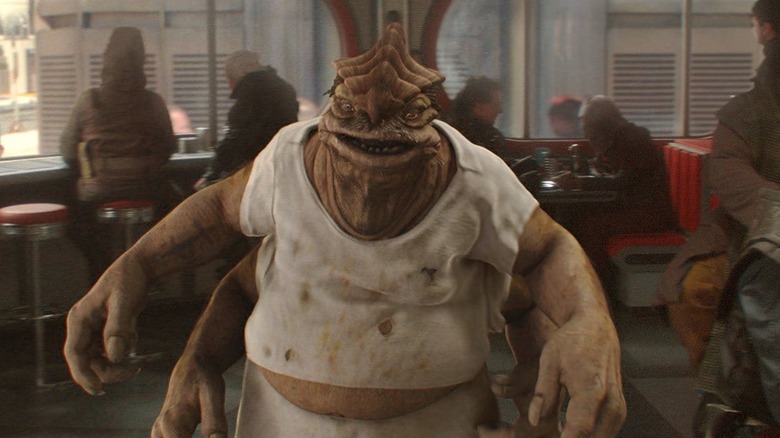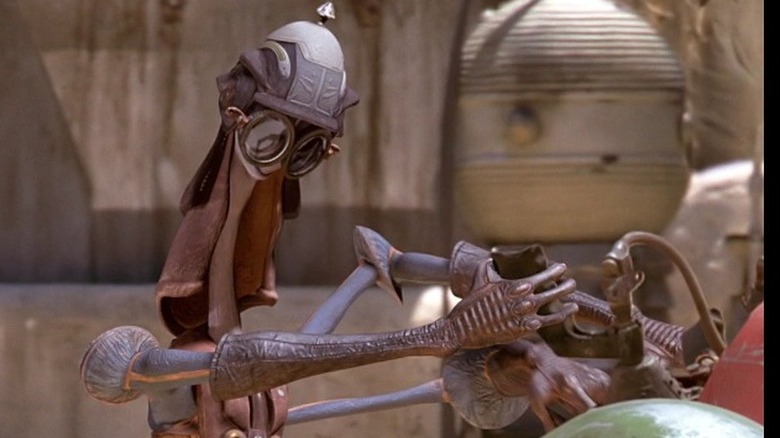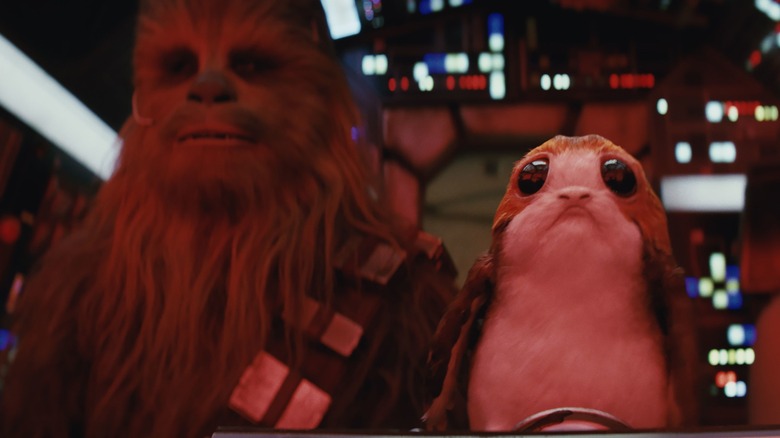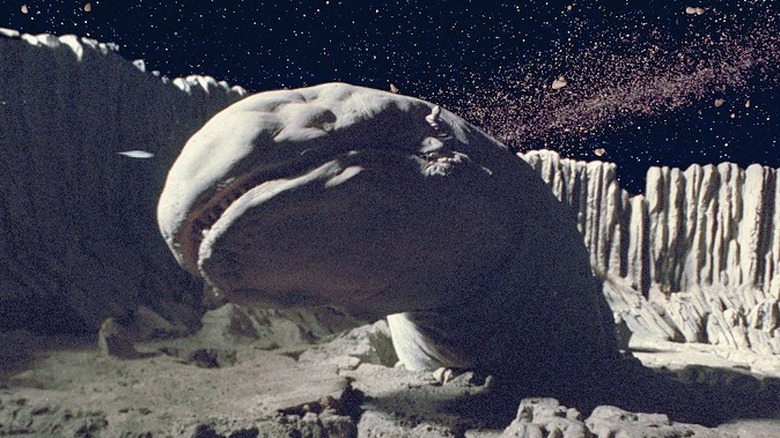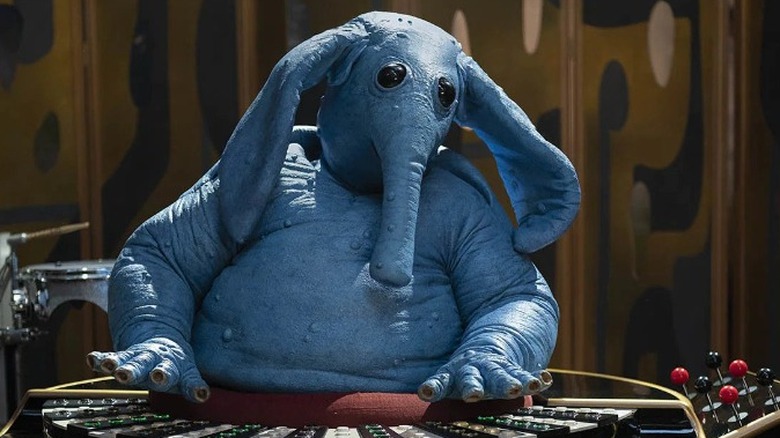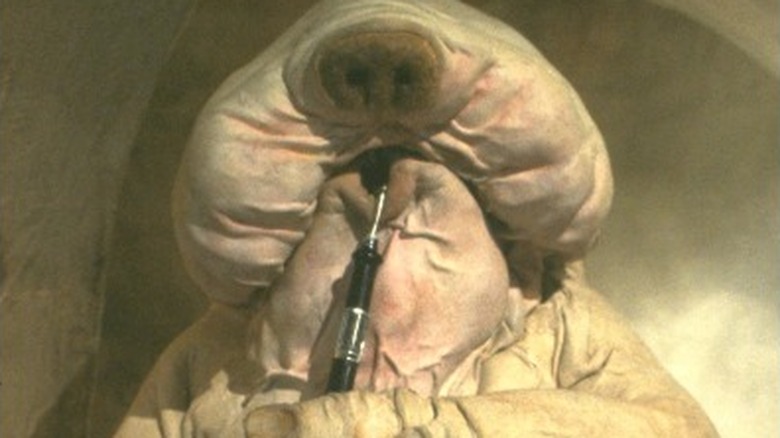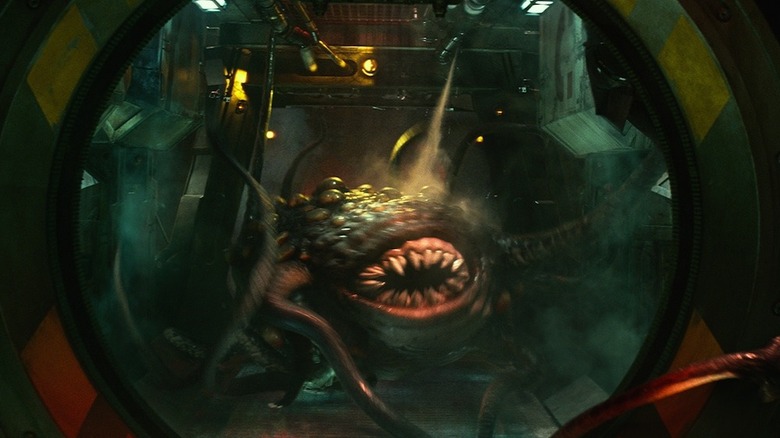Star Wars Aliens We Only Saw Once
The "Star Wars" universe is massive and filled with strange alien beings spread across a galaxy far, far, away. This multimedia franchise was the brainchild of George Lucas who started the phenomenon in 1977 with the very first "Star Wars" film. Since then, the series has exploded into nine main films, two spin-off movies, an animated film, and multiple television series, including "The Clone Wars" and "The Mandalorian". Suffice it to say, "Star Wars" isn't going anywhere anytime soon.
One of the features of "Star Wars" that makes it so interesting for fans is the level of creativity involved in making all the different species of aliens, even if they only appear for a moment. Unlike its main sci-fi competition, "Star Trek," the "Star Wars" universe isn't afraid to showcase aliens from other worlds that look truly different than the type of bipedal humanoids we're accustomed to. While most aliens in "Star Trek" are just humans painted a different color or given some face makeup, some species in "Star Wars" are genuinely bizarre to behold.
Certain "Star Wars" alien species show up repeatedly throughout the franchise, such as Yoda's unnamed species, which appears in both the original and prequel trilogy, as well as in "The Mandalorian" with the introduction of Grogu. However, most species are one-and-done. Part of the allure of this beloved space opera is that it will throw countless interesting science fiction concepts, stories, and alien races into the mix without always having the intention of bringing them back in any significant way. While almost every alien ever seen in the main films makes an appearance in the animated show at one point or another, this list will mainly focus on races only seen once in the main films, spin-offs, and Disney+ series.
Toydarian
Toydarians are a winged species of alien who resemble a large fly, and are traced back to their homeworld of Toydaria deep within Hutt-controlled space. They are unique among galactic species due to their ingrained ability to naturally resist attempts at mental manipulation by Jedi or Sith, making them worthy adversaries to any Force-reliant negotiators they encounter. Toydarians are generally regarded poorly by other galactic species thanks to their penchant for trickery, with one character from "Catalyst: A Rogue One Novel" describing them as "Such despicable beings, the Toydarians."
The most famous (and only) Toydarian we see in both the Skywalker Saga and spin-off films is the pernicious junk dealer Watto (introduced in "Star Wars: Episode I – The Phantom Menace"). His character is shown to be cold, greedy, and partially responsible for the events leading up to the rise of the Galactic Empire. After all, Watto puts it best himself in the first prequel film by saying to Qui-Gon Jinn, "I'm a Toydarian! Mind tricks don't work on me, only money." While a Toydarian monarch named King Katuunko does briefly appear in "The Clone Wars" series, there are no other Toydarians seen in any of the eleven canonical films released in the franchise.
Kaleesh
When it comes to merciless warriors in the "Star Wars" universe, few are as fearsome as the Kaleesh. Coming from the hostile and primitive planet of Kalee in an area referred to as "wild space," the Kaleesh are an aggressive society of fighters who are ruled by regional warlords locked in frequent combat with little interaction with the galactic community. Because of this, there is only one notable Kaleesh in the entire "Star Wars" universe who is ever actually seen: General Grievous.
General Grievous is a major antagonist of the prequel films, shown to be the Supreme Martial Commander of the Separatist Droid Armies throughout the Clone Wars. Born under the name Qymaen jai Sheelal, he became immersed in the ongoing galactic conflict between the Republic and Separatist forces, joining the latter as a dedicated general. Unlike most Kaleesh, Grievous underwent extensive cybernetic modification which completely changed his appearance with a Kaleesh-inspired cyborg body to better help him fight against the Jedi. Interestingly, the character was intended to be foreshadowing of what Anakin Skywalker would become through his own cybernetic transformation into Darth Vader. George Lucas explains this in a behind-the-scenes featurette by saying, "he's an alien in a droid shell, which is sort of an echo of what Anakin would become." Ultimately, General Grievous is the only major Kaleesh seen in the entire "Star Wars" franchise, showing up in "Star Wars: Episode III – Revenge of the Sith" and as a frequent antagonist in "The Clone Wars."
Asogian
Included in the films more as an easter egg than an actual species are the Asogians, who are members of the Galactic Senate when Naboo is invaded by the dastardly Trade Federation. Asogians are briefly seen during a hearing on one of the moving platforms in the senatorial chambers.
Little is known about Asogians in "Star Wars" lore, but they may look familiar to eagle-eyed fans, since they bear a striking resemblance to another iconic alien from popular culture. That's right, Asogians are nothing more than an on-screen homage to Steven Spielberg's blockbuster film "E.T. the Extra-Terrestrial," as they look identical to the lovable E.T. The inclusion of the Asogians in "Star Wars: Episode I – The Phantom Menace" was the result of a promise creator George Lucas made with Steven Spielberg to feature his little alien in a "Star Wars" movie after Spielberg featured Yoda and Boba Fett cameos in his own film. It's nice to see how friendship among peers can lead to fun moments like this. Nonetheless, Asogians are canonical in the "Star Wars" universe, with this being their one and only appearance.
Frog-dog
The appropriately named Frog-dog species is an alien race that, you guessed it, looks like a hybrid of a frog and a dog. These strange-looking lizards are unique in the galaxy, being seemingly non-sentient when first encountered, despite the fact that they are very much aware of their surroundings. In fact, this seems to be a conscious effort to look inconspicuous and less intelligent than they actually are as a defense mechanism. This species was often kept as pets thanks to their docile nature, such as in the case of Buboicullaar.
This creature is shown to be a personal pet of Jabba the Hutt who resides in his palace on Tatooine. It's unknown what the homeworld of this species is, since it's never explicitly stated, but it is clear that Frog-dogs can acclimate to other environments, such as the hard desert world in which Buboicullaar lives. Frog-dogs are unable or unwilling to speak in the commonly used Galactic Basic language (aka, English) but instead bark like dogs, such as when Buboicullaar says "Arf! Arf!" to C-3P0 as he brushes past him. Buboicullaar is the only Frog-dog we see in the "Star Wars" universe during the Jabba's Palace scene in "Star Wars: Episode VI – Return of the Jedi."
Besalisk
Another species introduced in the prequel trilogy to make only one appearance in the films is the Besalisk, a four-armed humanoid race hailing from the planet Ojom within the Deep Core. These are sturdy, tough, and powerful aliens who were known to be hardworking members of galactic society. The sole Besalisk seen in the "Star Wars" universe is none other than Dexter Jettster, owner and sole proprietor of Dex's Diner on Coruscant.
Jettster was a male Besalisk who served hot meals to all sorts of alien customers at his diner, where he mainly worked as a cook. He was also a known friend and confidant of Jedi Master Obi-Wan Kenobi, and his introduction to the "Star Wars" universe is when Kenobi visits his diner for information during the events of "Star Wars: Episode II – Attack of the Clones." Admittedly, there is one other notable Besalisk seen in "The Clone Wars" animated series named Pong Krell, who is a Jedi Master turned traitor during the show's fourth season. As far as the main films, however, Jettster is the only example of a Besalisk on-screen.
Xexto
Now here's a species that only hardcore "Star Wars" fans will remember: the Xexto. This six-limbed alien race comes from the distant Outer Rim world of Troiken, which fostered this unique species as an extremely adept organism. Xextos are mostly known for their talent at podracing, which is directly linked to the species' introduction into "Star Wars" canon with the Xexto podracer, Gasgano.
Gasgano is first shown in "Star Wars: Episode I – The Phantom Menace" as a male Xexto podracer on Tatooine alongside competitors like Sebulba and young Anakin Skywalker. Fans will recognize Gasgano during the thrilling Boonta Eve Podrace scene as piloting the green, dual-engine racer named "Ord Pedrovia," which survived the race by coming in second place. While there are some background Xexto audience members watching this race in the film, Gasgano remains the primary example of his species in the series, with no other Xexto showing up in later films or shows.
Porg
Everyone loves Porgs. We love Porgs, you love Porgs. If Porgs were real, everyone would have one as a pet. These adorable little sea birds are native species of the planet Ahch-To, where Luke Skywalker retreated in solitude between the events of "Star Wars: Episode VI – Return of the Jedi" and "Star Wars: Episode VIII – The Last Jedi." Porgs are shown to be cute, curious, and adorably dim-witted critters that are consistently attracted to shiny objects with a childlike wonder. Thanks to their lovability, Porgs were an immediate hit with fans. During one interview with Lucasfilm's Pablo Hidalgo, he explained the appeal of them by saying, "Porgs are cute. You fall into those deep, soulful eyes. I think a lot of people are going to want a Porg as a pet."
Porgs are introduced in "Star Wars: Episode VIII – The Last Jedi," where they are heavily featured throughout the entire film as comic relief. While there isn't one specific Porg to latch on to in the film, several are seen as stowaways on the Millennium Falcon and even during the Battle of Crait. These creatures are only seen once in the "Star Wars" universe, but they sure do get their fair share of screen time as an introduction. Beyond the films, Porgs do make appearances in endless merchandise and promotional material created by Disney to market the film (and the theme park "Star Wars: Galaxy's Edge").
Exogorth
Exogorths are giant, monstrous space slugs that live inside asteroids throughout the galaxy. They are apparently a sentient species despite their behavior being rather feral in nature, trapping ships in their massive mouths by pretending to be an open cave entrance. Exogorths can grow to be absolutely colossal in size, with some being as large as 900 meters in length from head to tail. There is only one major Exogorth seen in the entire "Star Wars" franchise, and that's Sy-O.
This space slug is encountered by the main cast of "Star Wars: Episode V – The Empire Strikes Back" as the Millennium Falcon unknowingly enters its mouth while attempting to hide from Imperial forces. Within the cave-like gullet of Sy-O, the ship is also attacked by native Mynocks, who live as parasites inside the Exogorth. These large worms were originally designed by artist Ralph McQuarrie as a piece of concept art which was later turned into the one on-screen Exogorth we see in the film, as seen in "The Art of Ralph McQuarrie".
Ortolan
Ortolan's are mostly known to fans thanks to the fame of their most iconic and artistically talented kinsman, but this species is more than just its most famous member. These creatures are small, blue, and goofy-looking bipeds with big floppy ears which drape down the sides of their head like little mini elephants. Ortolans are native to the planet of Orto in the Outer Rim, which is a cold and inhospitable world that turned this species into true survivors.
When "Star Wars" fans think of Ortolans, they always think of Max Rebo. This Ortolan is the most famous member of his species, as a musical legend who expertly plays the fan-favorite genre of Jizz as part of the "Max Rebo Band." His main client seems to be Jabba the Hutt, as he's introduced by playing tunes for the crime lord at his Palace as well as the floating barge Khetanna. Against all odds and reason, Max Rebo survived the destruction of Khetanna, living to jizz-wail another day. His is the only on-screen appearance of the species in the main "Star Wars" canon, having been introduced in "Star Wars: Episode VI — Return of the Jedi" and returning under the employment of Boba Fett in the Disney+ series "The Book of Boba Fett."
Dug
Yet another species introduced during the podracing sequence in "Star Wars: Episode I – The Phantom Menace" is the Dug, a small but determined race of creatures from the planet Malastare in the Mid Rim Territories. The primary Dug encountered in the "Star Wars" universe is none other than Sebulba, a major antagonist of Anakin Skywalker in the first prequel film. The two are rival podracers who go head-to-head during the Boonta Eve Podrace, with Sebulba using trickery and sabotage to give himself as many advantages as possible. He's described succinctly by Anakin himself in "Star Wars: Episode I – The Phantom Menace," who says, "Your buddy here was about to be turned into orange goo. He picked a fight with a Dug, an especially dangerous Dug called Sebulba."
Designing the Dug was an interesting part of the production process for "Star Wars: Episode I – The Phantom Menace,” since George Lucas had a particular vision for the species. According to Terryl Whitlatch in "Star Wars: The Making of Episode I – The Phantom Menace," Lucas envisioned the way these creatures would walk and move ahead of time. He said, "George had the idea of a creature that walks on his hands and uses his feet as arms. Sebulba looks a bit like an arachnid, although his face is something like an arrogant camel. We definitely wanted him to look creepy." Sebulba is the only Dug seen in any of the major films or shows, aside from a small circus master character named Preigo in "The Clone Wars" series.
Kitonak
Behold a truly obscure "Star Wars" species, the Kitonak. You may not even recognize these aliens since their appearance in the franchise is extremely minimal, but they're nonetheless interesting enough to deserve a shout-out here. The Kitonak are natives of the planet Kirdo III in the Outer Rim and have been briefly mentioned in the greater "Star Wars" lore. Apparently, this species is unique for its thick skin and ability to emit a delicious, vanilla-smelling odor from its bodies. Sounds tasty.
There's only one Kitonak ever seen in the entire franchise, even in animated series such as "The Clone Wars" that throw in as many obscure aliens as possible. That Kitonak's name? Droopy McCool. This amazingly named musician (who goes by the stage name Snit) is a proud member of Max Rebo's Band and is seen playing a chindinkalu flute in the background of "Star Wars: Episode VI – Return of the Jedi." Following the destruction of Jabba's barge and the loss of his employer, McCool's whereabouts remain unknown to this day. Unlike others on this list, the Kitonak race should be proud to have as cool of a species representative as Droopy McCool.
Rathtar
This feral, bloodthirsty species is one of the newer additions to the "Star Wars" canon, having been introduced in the first entry of J.J. Abrams' sequel trilogy in "Star Wars: Episode VII – The Force Awakens" as illegal cargo being smuggled by Han Solo. Rathtars are man-eating beasts from the toxic Outer Rim planet of Twon Ketee, where they are apex predators in their primitive world. Han Solo describes these animals best in the film when he simply says, "They are big and they are dangerous."
Rathtars were introduced into "Star Wars" as a scary (but not too scary) enemy for the main characters to face during Han Solo's re-introduction to the film. According to J.J. Abrams in the 3D Collector's Edition Blu-ray audio commentary for "The Force Awakens," Rathtars were meant to strike an interesting visual balance. He described them as "family-scary," meaning they were creepy enough to be exciting but not so horrifying that families and younger audiences would freak out seeing them. These creatures are only seen once in the "Star Wars" universe during their introduction, and never really heard from again.
